Middle East & Africa Transport and Logistics Market Size
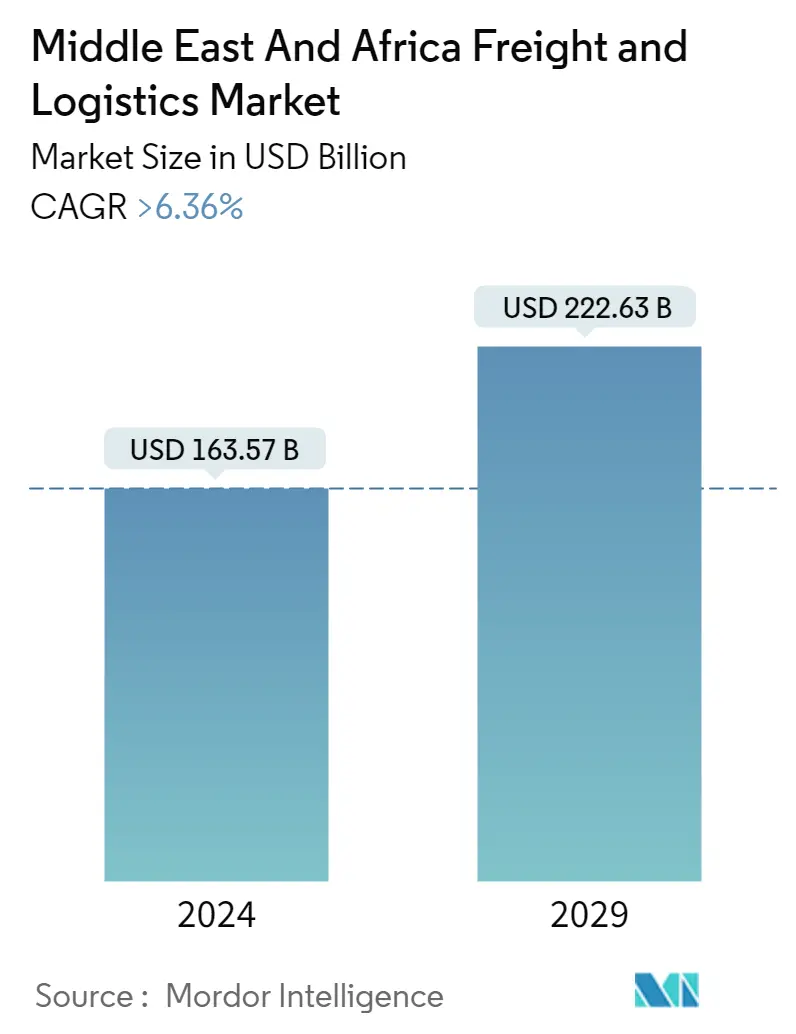
| Study Period | 2019 - 2029 |
| Base Year For Estimation | 2023 |
| Market Size (2024) | USD 163.57 Billion |
| Market Size (2029) | USD 222.63 Billion |
| CAGR (2024 - 2029) | > 6.36 % |
| Market Concentration | Low |
Major Players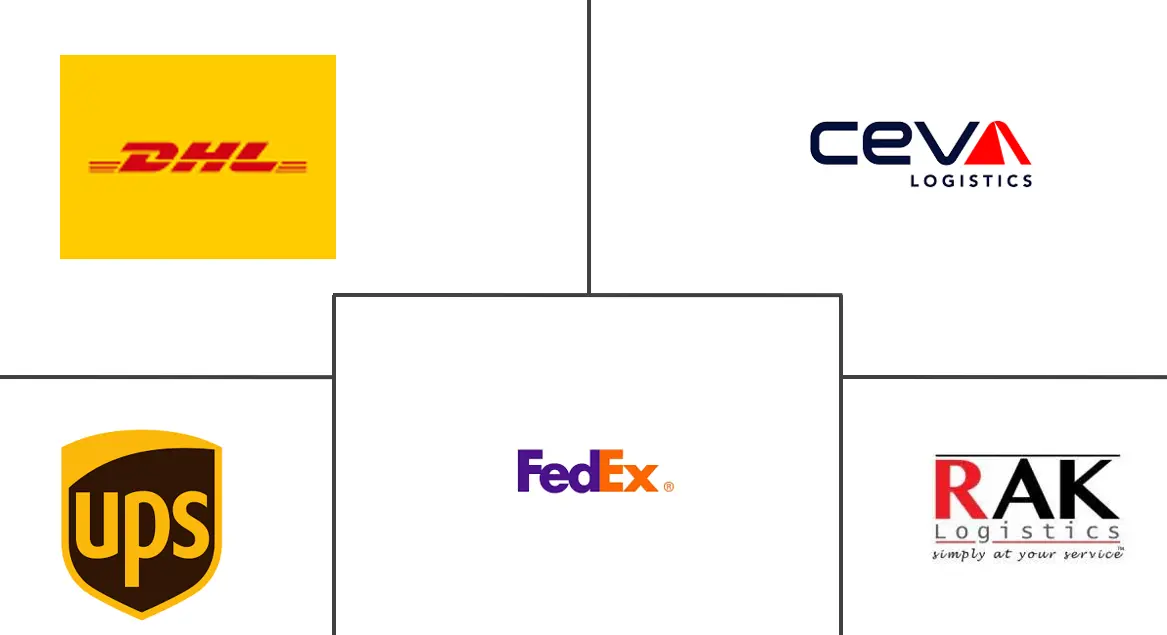
*Disclaimer: Major Players sorted in no particular order |
Need a report that reflects how COVID-19 has impacted this market and its growth?
Middle East & Africa Transport and Logistics Market Analysis
The Middle East And Africa Freight & Logistics Market size is estimated at USD 163.57 billion in 2024, and is expected to reach USD 222.63 billion by 2029, growing at a CAGR of greater than 6.36% during the forecast period (2024-2029).
During the past decade, globalization and technology created new opportunities for internationalization, boosting the supply chains and competitiveness in Africa. Currently, the most important countries in terms of logistics are Algeria, Angola, the Democratic Republic of Congo, Egypt, Ghana, Kenya, Mozambique, Nigeria, South Africa, and Tanzania. Some of them own key ports in the continent. For example, Barra owns Dande and Lobito in Angola, Lekki in Nigeria, Musoma in Tanzania, and Lamu in Kenya.
The political instability of some countries is likely to make territorial integration inappropriate in the short term. Domestic markets are predominant in this zone since there is little interaction among regions, which has led to a stagnation in international trade.
The economy is highly dependent on mining, which represents a third of the GDP. Morocco is a stable partner. Meanwhile, Egypt and Algeria have the highest production values. However, they are known for their little international interaction and lack of developed logistics corridors. African logistics companies are going beyond megacities and are looking to connect Africa's rural communities to regional supply chains.
While megacities are attracting millions of young Africans, Africa's population remains predominantly rural.
Despite a sustained period of decline over the last few years, affected by a fall in oil prices and geopolitical strife, Middle-East and Africa is fast becoming a region of automotive and supply chain opportunity. Carmakers such as VW, Toyota, GM, Groupe PSA, and Mercedes-Benz are investing in the local assembly, ranging from North African countries, including Morocco, Algeria, and Egypt, to sub-Saharan markets, such as Rwanda, Ethiopia, Kenya, and Ghana. The region also has some notable logistics developments.
Middle East & Africa Transport and Logistics Market Trends
Development of freight transport segment
- The Middle-East and African region is projected to grow significantly, with the Middle-East witnessing significant growth annually in terms of air transport. Cargo volumes are estimated to double in most countries of the region. At such levels, several challenges and opportunities arise. For airports in Africa and the Middle-East, this presents a stellar opportunity to capitalize on the growth potential and prepare for change, keeping the airlines and consumers at the heart of development and how it serves the national interest.
- In the Middle-East, the vast number of significant airport capital expansion programs are led by demand coming from the growth of domiciled carriers. However, there is also geographic proximity to major source markets, such as the Indian subcontinent and intercontinental traffic flows and the MENA regional travel. This factor and a favorable regulatory environment and governments, which have understood and harnessed the value of aviation, have led to the development of airport hubs that are catering to some of the largest movements of passenger and cargo traffic globally.
- Airports in the Gulf have led this trend, with Dubai, Abu Dhabi, Bahrain, Doha, Muscat, and Jeddah investing billions of dollars in infrastructure and focusing on improving the passenger experience. This investment is due to the close symbiotic relationships the airports have with domiciled carriers such as Emirates Airlines, Etihad Airways, Qatar Airways, and Saudi Arabian Airlines, which enable most stakeholders in the value chain to work together and develop an end-to-end experience, serving the industry and the respective local economies.
- Like their global peers, airports in the Middle-East aspire to overcome project development challenges through effective stakeholder collaboration, capitalizing on digitization, the airport retail revolution, and non-aeronautical opportunities. In addition, they aim to create personalized experiences by offering guests a sense of place with enough capacity. Airport developers in the Middle-East are also striving to achieve green building credentials through international certifications and those developed by national programs while working toward ACI carbon accreditation.
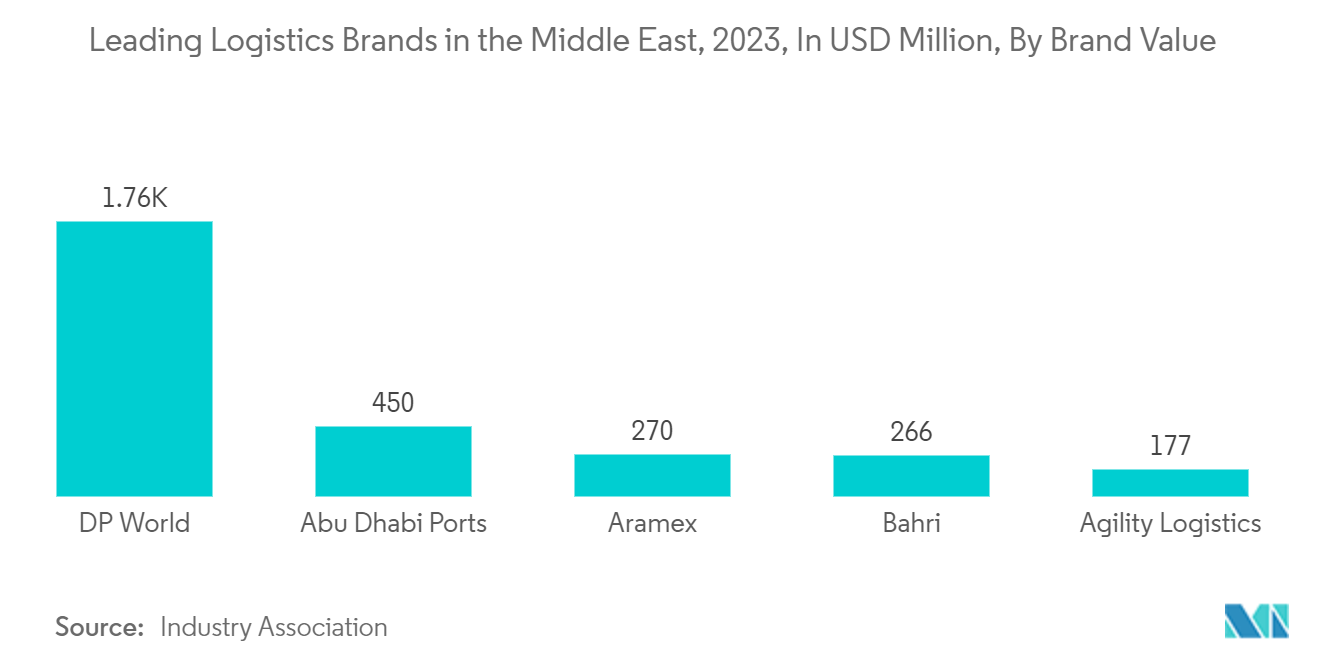
E-commerce Driving the Logistics Industry
- According to the present economic situation in Saudi Arabia, the logistic sector, with its pillars of aviation, roads & transport, railways, warehousing & marine, is expected to be a key factor in helping the Saudi economy to continue to grow in the near future.
- Saudi Arabia is already considered to be an important international logistics hub, because of its central geographical location at the crossroads of the main international trade routes, amidst three continents, namely Asia, Europe, and Africa, in addition to its size and its large economy on the Arabian Peninsula. However, location and size are not sufficient to be considered an important logistics hub. Therefore, the country has taken up an ambitious plan to improve its logistics infrastructure with specialized facilities and new economic zones.
- This plan - the Saudi Vision 2030 - was launched by Crown Prince Mohammed bin Salman in 2016 to reduce the Saudi dependence on oil. It encompasses a nine-point strategy of process streamlining, market liberalization, privatization, infrastructure enhancement, the establishment of new free economic zones and governance, and regulatory reforms to maximize its strategic advantage to evolve into the “go-to logistics hub” for the Middle East region.
- Out of all the Middle Eastern and North African (MENA) countries, Saudi Arabia has witnessed the biggest changes and activity in the logistics industry during the last 2 to 3 years.
- The Kingdom has recently developed the logistics sector through a capital investment of more than USD 106.6 billion. This allowed an increased capacity in the land, air, and maritime cargo, in addition to the development of and simplification of the import/export operations and the removal of all restrictions related to logistics operations.
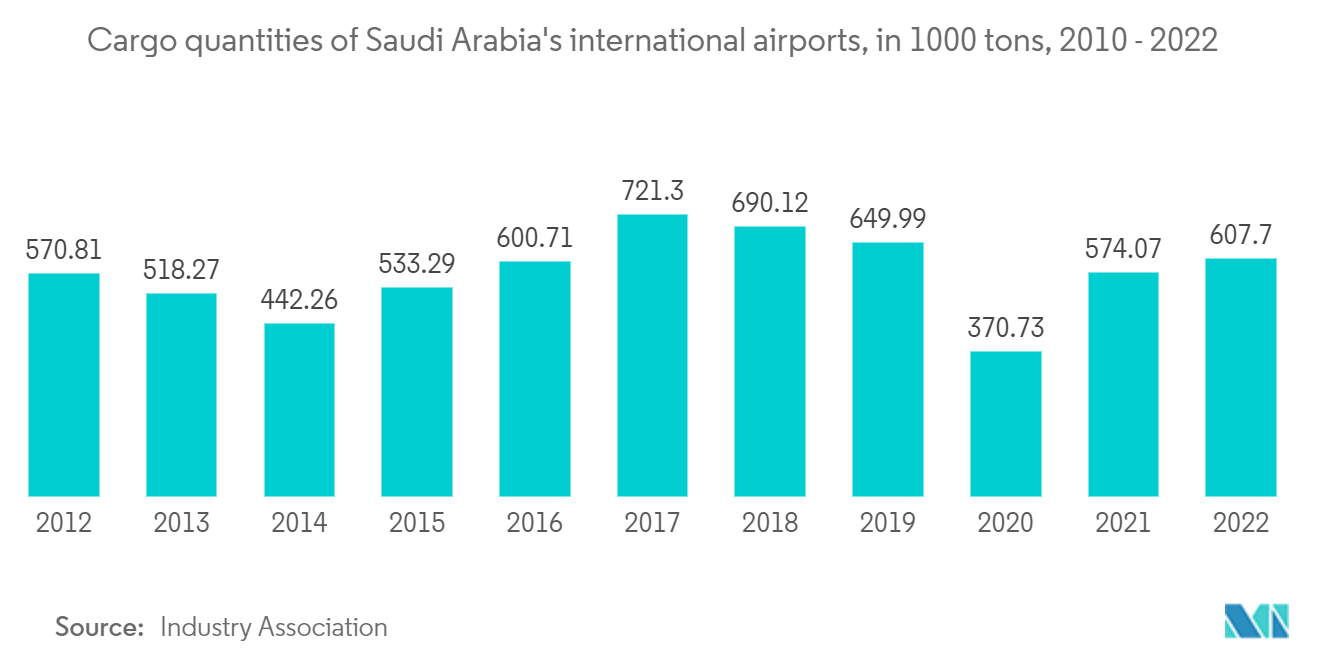
Middle East & Africa Transport and Logistics Industry Overview
The Middle-East and African freight and logistics market is fragmented, with the presence of international and local players. The market is dominated by major international players like DHL, FedEx, and UPS. The market is expected to grow during the forecast period due to growing e-commerce and growing infrastructure in the region.
Middle East & Africa Transport and Logistics Market Leaders
DHL
FedEx
UPS
RAK Logistics
Ceva Logistics
*Disclaimer: Major Players sorted in no particular order
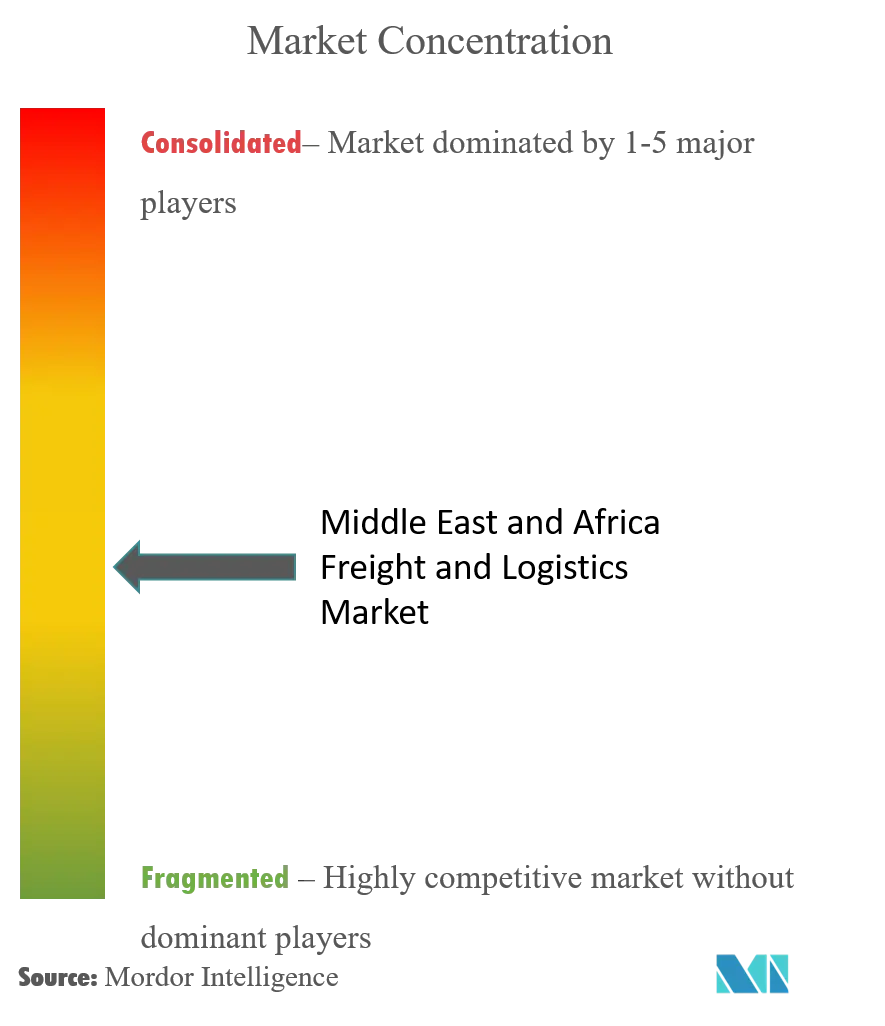
Middle East & Africa Transport and Logistics Market News
- May 2023: Saudi Logistics Services (SAL) and Lufthansa Technik Logistik Services (LTLS) have signed an initial Memorandum of Understanding (MoU) to collaborate on the logistics activities of LTLS within Saudi Arabia. Under this MoU, SAL will provide freight forwarding, transportation, and customs brokerage services to support LTLS' maintenance logistics operations for their key customers around Saudi Arabia. As a result, LTLS would subsequently strengthen its logistics services coverage within Saudi Arabia.
- April 2023: Saudi Arabia's Almajdouie Logistics expanded its fleet size by adding 30 new Hyundai Xcient trucks. The engine produces 440 horsepower, making the Hyundai Xcient one of the most powerful heavy-duty trucks globally.
Middle East & Africa Transport and Logistics Market Report - Table of Contents
1. INTRODUCTION
1.1 Study Assumptions and Market Definition
1.2 Scope of the Study
2. RESEARCH METHODOLOGY
3. EXECUTIVE SUMMARY
4. MARKET DYNAMICS
4.1 Market Overview
4.2 Market Drivers
4.2.1 Rise In E-commerce Growth in The Region
4.2.2 Development of Logistic Infrastructure
4.3 Market Restraints
4.3.1 Poor Infrastruture
4.4 Market Opportunities
4.4.1 Logistics turns to tech to meet new demand
4.4.2 Government Initiatives
4.5 Value Chain/Supply Chain Analysis
4.6 Porter's Five Forces Analysis
4.6.1 Threat of New Entrants
4.6.2 Bargaining Power of Buyers/Consumers
4.6.3 Bargaining Power of Suppliers
4.6.4 Threat of Substitute Products
4.6.5 Intensity of Competitive Rivalry
4.7 Impact of COVID-19 on the market
5. MARKET SEGMENTATION
5.1 By Function
5.1.1 Freight Transport
5.1.1.1 Road
5.1.1.2 Water
5.1.1.3 Air
5.1.1.4 Rail
5.1.2 Freight Forwarding
5.1.3 Warehousing
5.1.4 Value-added Services and Other Functions
5.2 By End User
5.2.1 Manufacturing and Automotive
5.2.2 Oil and Gas, Mining, and Quarrying
5.2.3 Agriculture, Fishing, and Forestry
5.2.4 Construction
5.2.5 Distributive Trade (Wholesale and Retail Segments - FMCG Included)
5.2.6 Other End Users (Telecommunications and Pharmaceuticals)
5.3 By Country
5.3.1 United Arab Emirates
5.3.2 Saudi Arabia
5.3.3 Qatar
5.3.4 South Africa
5.3.5 Egypt
5.3.6 Morocco
5.3.7 Nigeria
5.3.8 Rest of Middle-East and Africa
6. COMPETITIVE LANDSCAPE
6.1 Overview (Market Concentration and Major Players)
6.2 Company Profiles
6.2.1 DHL
6.2.2 FedEx
6.2.3 Kuehne + Nagel
6.2.4 United Parcel Service Inc.
6.2.5 RAK Logistics
6.2.6 Al-Futtaim Logistics
6.2.7 Agility Logistics
6.2.8 Saudi Transport & Investment Co. (Mubarrad)
6.2.9 Almajdouie Group
6.2.10 Ceva Logistics
6.2.11 Gulf Agency Company (GAC)
6.2.12 International Freight Group*
- *List Not Exhaustive
7. FUTURE OUTLOOK OF THE MARKET
8. APPENDIX
Middle East & Africa Transport and Logistics Industry Segmentation
Logistics is a part of supply chain management that deals with the efficient forward and reverse flow of goods, services, and related information from the point of origin to the point of consumption according to the needs of customers.
The Middle East and Africa Logistics Market is Segmented by function, by end-user, by country. By function the market is segmented by freight transport, freight forwarding, warehousing, and value-added services and other services by end user the market is segmented by manufacturing and automotive, oil and gas, mining, and quarrying, agriculture, fishing, and forestry, construction, distributive trade, healthcare and pharmaceutical, and other end users by country the market is segmented by United Arab Emirates, Saudi Arabia, Qatar, South Africa, Egypt, Morocco, Nigeria, and Rest of Middle-East and Africa. The report offers market sizes and forecasts for the market in value (USD) for all the segments.
| By Function | ||||||
| ||||||
| Freight Forwarding | ||||||
| Warehousing | ||||||
| Value-added Services and Other Functions |
| By End User | |
| Manufacturing and Automotive | |
| Oil and Gas, Mining, and Quarrying | |
| Agriculture, Fishing, and Forestry | |
| Construction | |
| Distributive Trade (Wholesale and Retail Segments - FMCG Included) | |
| Other End Users (Telecommunications and Pharmaceuticals) |
| By Country | |
| United Arab Emirates | |
| Saudi Arabia | |
| Qatar | |
| South Africa | |
| Egypt | |
| Morocco | |
| Nigeria | |
| Rest of Middle-East and Africa |
Middle East & Africa Transport and Logistics Market Research FAQs
How big is the Middle East And Africa Freight & Logistics Market?
The Middle East And Africa Freight & Logistics Market size is expected to reach USD 163.57 billion in 2024 and grow at a CAGR of greater than 6.36% to reach USD 222.63 billion by 2029.
What is the current Middle East And Africa Freight & Logistics Market size?
In 2024, the Middle East And Africa Freight & Logistics Market size is expected to reach USD 163.57 billion.
Who are the key players in Middle East And Africa Freight & Logistics Market?
DHL, FedEx, UPS, RAK Logistics and Ceva Logistics are the major companies operating in the Middle East And Africa Freight & Logistics Market.
What years does this Middle East And Africa Freight & Logistics Market cover, and what was the market size in 2023?
In 2023, the Middle East And Africa Freight & Logistics Market size was estimated at USD 153.79 billion. The report covers the Middle East And Africa Freight & Logistics Market historical market size for years: 2019, 2020, 2021, 2022 and 2023. The report also forecasts the Middle East And Africa Freight & Logistics Market size for years: 2024, 2025, 2026, 2027, 2028 and 2029.
Middle East and Africa Logistics Industry Report
Statistics for the 2024 Middle East And Africa Freight & Logistics market share, size and revenue growth rate, created by Mordor Intelligence™ Industry Reports. Middle East And Africa Freight & Logistics analysis includes a market forecast outlook to for 2024 to 2029 and historical overview. Get a sample of this industry analysis as a free report PDF download.
